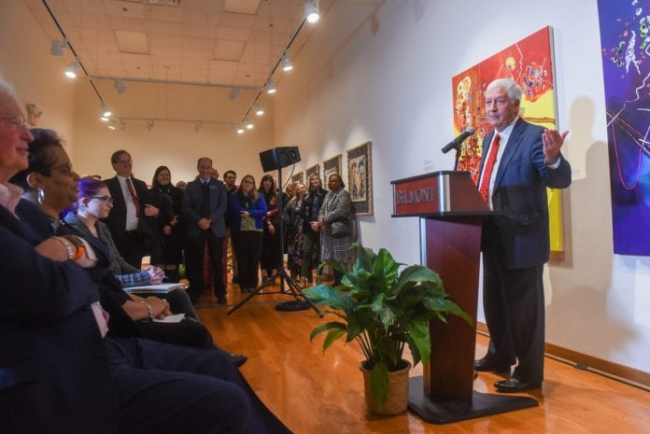You have /5 articles left.
Sign up for a free account or log in.

Bob Fisher, president of Belmont University, announces the planned merger with the Watkins College of Art.
Belmont University
Watkins College of Art, a small private four-year art and design college in Nashville, Tenn., will merge with nearby Belmont University this August.
The acquisition is the second of its kind for Belmont University in the past two years. Belmont, a growing private Christian institution that is set to host the third and final presidential debate of 2020, recently merged with the O’More College of Design and sold the college’s former campus.
Both mergers speak to the challenges faced by small colleges to keep their doors open amid shrinking enrollments and spiraling overheads. Both O’More and Watkins were enrolling fewer than 200 students when Belmont stepped in to incorporate them into its campus.
The challenges facing small colleges aren’t limited to art schools. Marlboro College, a private liberal arts institution in Vermont with around 150 students, will soon be absorbed by Emerson College in Boston. Two former Marlboro faculty members are spearheading an effort to keep the college open and independent.
According to National Center for Education Statistics data, Belmont's enrollment increased to over 8,000 in fall 2018, up from around 2,000 students in the year 2000. Watkins’s enrollment has nearly halved in the last five years, from 304 in fall 2014 to around 160 students today.
“In today’s educational environment, obviously, let’s address it, it’s becoming more and more difficult for small colleges, particularly specialized [colleges] like ours, to perpetuate themselves,” said J. (Joseph) Kline, president of Watkins College of Art, at an event announcing the merger yesterday. “We have done that for 135 years. We have had many iterations. I assure you, with all sincerity, this is the best one we’re ever going to have. Hopefully, this is the last one.”
The merger was voted for “enthusiastically and unanimously” by the boards of both Watkins and Belmont, said Kline. A newly created Watkins College of Art at Belmont will take in students majoring in fine arts, graphic design, illustration, photography and art. Watkins students studying interior design will join peers in the O’More College of Architecture and Design. Watkins’s film major will merge with Belmont’s motion pictures program in the Curb College of Entertainment and Music Business. It is not clear whether all of Watkins's faculty and staff will be given jobs at Belmont.
Watkins’s 13-acre campus will be sold and the proceeds used to create an endowment that will support scholarships for Watkins students. Students who are currently enrolled at Watkins will continue to pay Watkins prices for the duration of their studies at Belmont. Watkins students pay approximately $31,600 per year for tuition, fees and on-campus housing, while Belmont students pay $49,920.
“I don’t expect everyone to embrace this decision immediately,” said Bob Fisher, president of Belmont University, at an event Tuesday. “Just two years ago we made a similar announcement [with O’More College of Design]. There’s always questions about relationship changes, but that has been a wonderful event for Belmont, and we have seen a resurgence in enrollments at O’More that has been really pretty remarkable.”
Belmont seems like a good fit for Watkins, said Susan Resneck Pierce, president emerita of the University of Puget Sound and a consultant for colleges and presidents (and an occasional contributor to Inside Higher Ed). “Belmont is bringing programs onto their campus that are consistent with their mission. They are expanding what they are already doing in a way that works for them and that they hope will work for Watkins.” She added, “Often mergers fail because they can’t agree on governance -- that doesn’t seem to be the case here.”
More mergers of small colleges, not just art schools, are likely on the horizon, said Pierce. “These colleges provide an alternative approach to education that was very desirable at one time. But research shows that students want large rather than small, urban rather than rural. The misguided, in my opinion, value placed on pre-professional education over the liberal arts has made these colleges even more vulnerable.”
While many college presidents are thinking about mergers and the potential benefits of greater economies of scale, some leave it too late. “Often places wait too long for a merger, until they are so weak they are no longer a desirable partner. Two weak links don’t make a strong chain.”
Operating a higher education institution of any kind with fewer than 200 students is “extremely challenging,” said Deborah Obalil, president and executive director of the Association of Independent Colleges of Art and Design. “You have all the same administrative and compliance requirements of a larger institution, without any savings afforded by scale,” she said. AICAD is a membership organization that represents 39 art and design colleges in the U.S. and Canada, including Watkins College of Art.
“While art and design enrollment has been on the rise in the last two years over all, and while interest in art and design majors is projected to continue increasing in the near future, we’ve seen that individual very small institutions face challenges in growing their enrollments fast enough to mitigate the rising operating costs in higher education,” said Obalil.
For some small colleges, particularly in the arts, mergers can have positive outcomes, said Obalil. She noted that the merger of the School of the Museum of Fine Arts Boston into Tufts University a few years ago “resulted in greater investment in both faculty and student support while maintaining the unique culture for which SMFA was known.” The 1998 merger of the Art Institute of Boston into Lesley University “ultimately resulted in a purpose-built campus for art and design with much greater resources available to both faculty and students,” said Obalil.
“That said, if history has taught us anything, it is that each merger is unique and none are without unexpected challenges along the way.”








